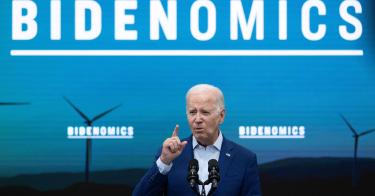Have you noticed that you’re constantly being prompted to tip lately—or tip more—especially at places where doing so wasn’t common in the past?
It’s called “tip-flation,” and you’re not alone. About two-thirds of Americans have “tipping fatigue,” which is being asked for a tip when they don’t want to give one. It is one way you’re paying for “Bidenomics” and the higher costs it produces for businesses.
Since President Biden’s inauguration, businesses have seen prices rise about 16%, and those costs have been passed on to consumers in the form of higher prices. Over the last 2½ years, the cost of living has increased at rates not seen in four decades.
That has left workers demanding higher wages, and businesses without the profit margins to pay for them.
>>> Inflation: Who’s Really at Fault?
Likewise, businesses are aware that customers are getting squeezed from every angle, especially on necessities such as food, housing and transportation. Raising prices directly is likely to cause cost-conscious consumers to go elsewhere, and that’s where the guilt trip of tipping comes in.
To be clear, this new phenomenon is not about places like full-service restaurants where tipping has been common for ages, having become ingrained in the nation’s culture. In those establishments, Americans are among the best tippers in the world, and it is a highly efficient way to promote good service.
But now people are being asked to extend that gratuity to the point of charity, including in some unusual places. It’s not uncommon today for kiosks, where you are taking your own order, to prompt customers for tips of 30%. Customers are even being prompted to tip in many fast-food and adjacent restaurants where you bus your own tray.
The size of tips being suggested is also alarming. At many establishments where tipping used to be considered optional, like coffee shops, customers are now presented with a screen of tip options upon paying, and 20% is the lowest one. One-third of people say they give large tips for things like a cup of coffee because they feel pressured to do so.
The demand for tips seems ubiquitous. Three-quarters of online food and beverage orders have prompts to tip staff. Even some stores and auto shops are laying the guilt trip on customers.
These extra costs add up in a big way. Aggregate tips increased over 25% in the third quarter of 2022 alone, but that’s ignored by most inflation measurements.
The Bureau of Labor Statistics will release July’s consumer price index data on Thursday. Without a doubt, it will show an acceleration of inflation from the previous month.
>>> Question Biden’s Mismanagement at Your Own Financial Risk
But something will be missing from the CPI: the cost of tipping.
That’s because, despite its utility, the CPI doesn’t include many costs that consumers pay daily. For example, the CPI includes the cost of food at a restaurant, or the price of a haircut, but not the tips paid on those services.
It also doesn’t capture the nontraditional ways in which people are being asked to tip today.
That means the CPI figures effectively overlook half the increase in the cost of eating out that customers have seen over the last year.
Tip-flation is just one of many examples that illustrates how official metrics fail to capture the full impact of inflation, which is the result of the government spending, borrowing, and printing too much money. But Bidenomics ignores all that, relying instead on the hidden tax of inflation to pay for multitrillion-dollar deficits.
More tips will hurt your wallet, but it won’t solve the problem. Reversing Bidenomics, however, will bring relief to workers, customers and businesses alike.
And that’s the best tip this economist can give.
This piece originally appeared in The Washington Times




